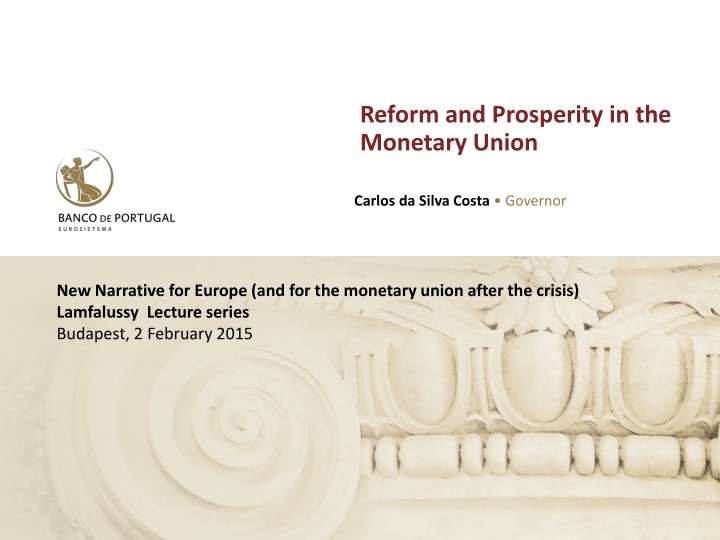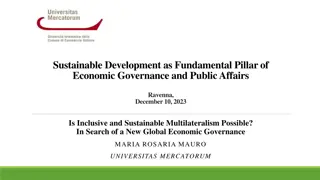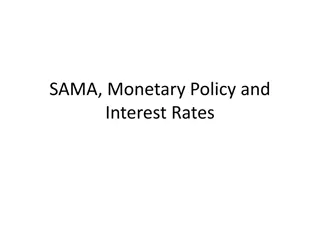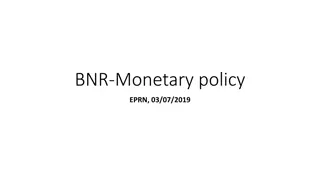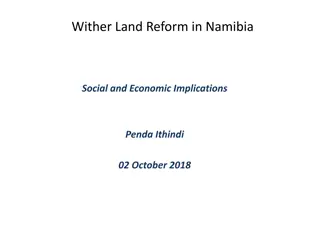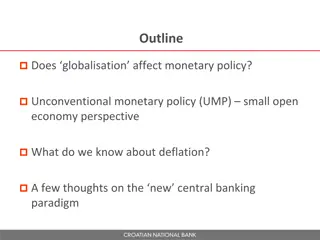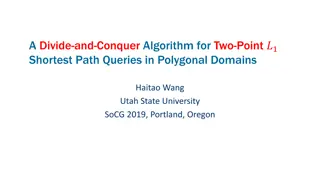Reform and Prosperity in the Monetary Union: A Path to Sustainable Growth
The lecture series highlights the symbiotic relationship between the Monetary Union and economic growth, emphasizing the need for sustainable economic policies at both national and European levels. It discusses the role of Monetary Union in facilitating sustainable development while addressing the challenges of national fiscal policies and the necessity for reforms. The presentation delves into the complexities of balancing public finances, safeguarding financial stability, and managing shocks effectively within the Union.
Download Presentation

Please find below an Image/Link to download the presentation.
The content on the website is provided AS IS for your information and personal use only. It may not be sold, licensed, or shared on other websites without obtaining consent from the author.If you encounter any issues during the download, it is possible that the publisher has removed the file from their server.
You are allowed to download the files provided on this website for personal or commercial use, subject to the condition that they are used lawfully. All files are the property of their respective owners.
The content on the website is provided AS IS for your information and personal use only. It may not be sold, licensed, or shared on other websites without obtaining consent from the author.
E N D
Presentation Transcript
Reform and Prosperity in the Monetary Union Carlos da Silva Costa Governor New Narrative for Europe (and for the monetary union after the crisis) Lamfalussy Lecture series Budapest, 2 February 2015
Outline I. Monetary Union and Economic Growth II. Reforms at national level III. Reform at the European Level IV.Conclusions 2
I. Monetary Union and Economic Growth Is there a trade-off between the Monetary Union and economic growth? No. They are complementary. The sustainability of the Monetary Union depends: Need to implement sustainable economic policies At National level But not sufficient At Need have policy instruments to absorb shocks that Member State are subject to European level 3
I. Monetary Union and Economic Growth Monetary Union & National Fiscal Policy Facilitates the implementation of a sustainable development strategy - reduces the cost and the availability of credit and increases economic agents confidence in nominal stability Intensifies and prolongs the imbalances created by unsustainable fiscal and economic policies private agents increase leverage, public debt constraint is eased, internal demand pressures imply a deterioration of competitiveness (via increases in real wages above productivity) Exacerbates the conflict between sustainability of public finances and safeguarding financial stability monetisation of banks bail out is not possible, financial repression can not the used to help absorb public costs with the recapitalization of the banking system Limits sovereign leeway to deal with idiosyncratic shocks and with asymmetric effects of common shocks 4
II. Reforms at national level At the National Level: Need for Economic Policy that compensates these effects: Countercyclical Fiscal Policy 1 Rise in indebtedness of households and firms Private expenditure boom financed by credit Macroprudential policy to manage the buildup of risks Increase in relative price of non-tradables 2 Increase in the share of the non-tradables sector Upward wage pressure Income policy that safeguards the competitiveness 3 Deterioration in competitiveness Deterioration in current account Accumulation of a substantial negative net foreign asset position 5
III. Reforms at European level At the European Level: Surveillance and monitoring the sustainability of national policies (fiscal and income policies) 1 Financial support mechanisms to fix unsustainable situations of Member States based on a commitment to an economic and fiscal adjustment path with financial assistance conditional of the adjustment progress 2 Risk sharing through integrated financial markets: Single Supervisory Mechanism, Single Resolution Framework (Single Resolution Mechanism and Single Resolution Fund) and Single Deposit Guarantee Scheme 3 Mechanisms to compensate the effects of idiosyncratic shocks and the asymmetric effects of common shocks 4 6
III. Reforms at European level A Monetary Union with mechanisms that supports sustainability - mitigates the inconsistency between the singleness of the monetary policy and national budgetary sovereignty promotes economic growth But it is not sufficient to guarantee the optimization and the sustainability of economic growth The sustainability of public finances is guaranteed but not a growth path consistent with the natural rate of unemployment .it can coexist with a suboptimal equilibrium! 7
IV. Conclusions The nature of national economic policies and the coordination of these policies at area level as a whole determines the sustainability of the development model (growing imbalances in the labor market ultimately determine the sustainability of fiscal policy) We need an integrator power of national economic policies that takes into account the path of potential output and employment in the area as a whole. Direct and indirect instruments (via Member States) to manage aggregate demand, investment and potential output must be in place The sustainability of the monetary union depends on the nature and integrative capacity of the mechanisms that ensure the integration of national policies, that is the economic integration stage and the corresponding institutional framework 8
Carlos da Silva Costa Governor New Narrative for Europe (and for the monetary union after the crisis) Lamfalussy Lecture series Budapest, 2 February 2015
